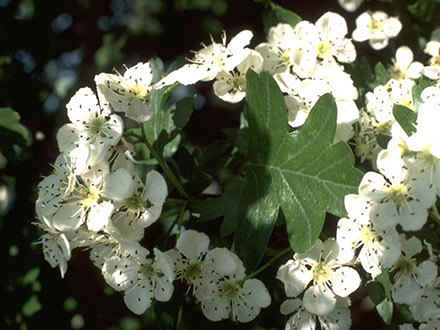Botanical name
Crataegus monogyna Jacq.
Crataegus laevigata (Poir.) DC. (Syn. C. oxyacantha auct. L.)
Family
Rosaceae
Common name
Common hawthorn, Whitethorn, One-seed hawthorn, Single-seed hawthorn
Midland hawthorn, Mayflower, English hawthorn
Information about the plant
The genus Crataegus is a large genus whose systematic classification is complex because the species easily hybridize. Depending on the classification criteria, 150 to 2000 species can be described, of which only 100 to 200 can be considered true species. The common hawthorn is native to southern and northern Europe, Russia, Siberia, the Himalayas, North Africa, Chile, and China. The Midland hawthorn is distributed throughout Europe and is also cultivated in America. Both hawthorn species grow as shrubs in deciduous forests, thickets, and hedges, as well as along fences, gardens and parks. "Hawthorn" refers to the white flowers and spiny branches of these large shrubs. They are in full bloom from May to June - the common hawthorn two weeks before the Midland hawthorn - and during this time, they dominate our landscape with their white flowers.
The two species differ by the number of styles in the flower. However, this distinction is not entirely reliable, as the flower of the monogynous hawthorn (monogyna = monoecious, from the Greek ‘gyne’ = female) can sometimes have two styles, while the Midland hawthorn can have three styles, or rarely, just one. A better way to distinguish them is by their leaf shape. The leaves of the common hawthorn are deeply lobed, whereas those of the Midland hawthorn are diamond-shaped and serrated. The small white flowers grow in clusters and, after fertilization, ripen on both species into small, bright red drupes, which make the shrubs look very decorative in the autumn.
Medicinally used parts of plants (herbal drug)
The dried flower-bearing twigs (Crataegi folium cum flore) and dried fruits (Crataegi fructus) are used. The commercially available drug is sourced from various Eastern and Southern European countries.
Constituents of the herbal drug
Hawthorn leaves with flowers contain flavonoids, oligomeric procyanidins, and caffeoylquinic acids. Hawthorn fruits contain oligomeric procyanidins and flavonoids.
Quality of the drug
The quality of the following drugs or drug preparations is specified in the European Pharmacopoeia (Ph. Eur.):
- Hawthorn leaf with flowers (Crataegi folium cum flore)
- Hawthorn leaf with flowers dried extract (Crataegi folii cum flore extractum siccum)
- Quantified liquid extract of hawthorn leaf with flowers (Crataegi folii cum flore extractum fluidum quantificatum)
- Hawthorn fruit (Crataegi fructus)
According to the pharmacopoeia, hawthorn leaves with flowers and hawthorn fruits from hybrids of the common hawthorn and Midland hawthorn can be used. Additionally, C. pentagyna Waldst. & Kit., C. nigra Waldst. & Kit. and C. azarolus L. are, according to the pharmacopoeia, approved as source plants for the drug.
The quality of the following drugs or drug preparations is specified in the German pharmaceutical Codex (DAC):
- Hawthorn flowers (Crataegi flos)
- Hawthorn tincture from leaves and flowers (Crataegi tinctura e foliis cum floribus)
Medical applications
Recognised medical use
Hawthorn leaf with flowers
The HMPC has classified hawthorn leaves with flowers as a traditional herbal medicinal product (see ‘Traditional use’).
ESCOP: For finished medicinal products with alcoholic extracts as the active ingredient, the indication is for declining cardiac performance (heart failure) corresponding to stage II, according to the NYHA (New York Heart Association). For tea and other preparations, the indication is ‘nervous heart complaints and support of cardiovascular function’.
Hawthorn fruits
ESCOP: For nervous heart complaints and to support cardiovascular function.
Traditional use
Hawthorn leaves with flowers have been classified by the HMPC as a traditional herbal medicinal product (Article 16a of Directive 2001/83/EC). Based upon long-standing use, hawthorn leaves with flowers can be used for intermittent nervous heart complaints (e.g. palpitations, anxiety-induced extrasystoles) if a serious illness has been ruled out by a doctor. Also, it can be used for mild stress symptoms and as a sleep aid.
Hawthorn fruits: Traditionally used to support cardiovascular function (traditional use according to Article 16a of Directive 2001/83/EC).
Herbal drug preparations in finished dosage forms
Hawthorn leaf with flower
- Chopped hawthorn leaves with flowers for tea preparation
- Powdered drug in tablets
- Dry extracts in capsules, tablets, coated tablets, and dissolved in drops
- Liquid extract in drops
- Fresh plant press juice
- Crataegus homeopathic mother tincture in liquid preparations
- Powdered hawthorn fruits in tablets
- Dry extracts in coated tablets and capsules
- Alcoholic extract in drops
Dosage
Finished medicinal product: See patient information leaflet.
Tea: Drink a cup of hawthorn tea (hawthorn leaves with flowers) 3 to 4 times a day for several weeks. Average daily dose 3.0 to 6.0 g drug.
Preparation of a tea
Pour approximately 150 mL of boiling water over 1.0 to 1.5 g of finely chopped hawthorn leaves with flowers and strain after 15 minutes. Hawthorn fruits are not suitable for tea preparation.
Notes
If the symptoms persist for more than 6 weeks or there is water retention in the legs or pain in the heart area that can radiate to the arms, upper abdomen or neck, urgent medical advice is required.
No safety studies are available on the use of hawthorn leaves with flowers and hawthorn fruits during pregnancy and lactation. The use in children under 12 years of age is not recommended due to a lack of evidence.
Side effects
None known.
Interactions
None known.
References
Herbal drug monographs
HMPC (2016), ESCOP (2003, 2009), WHO (Vol. 2, NIS)
Further literature
Commentary on the European Pharmacopoeia (Hawthorn leaves with flowers, No. 1432; Hawthorn leaves-with-flower-dry extract, No. 1865; Hawthorn leaves-with-flower-fluid extract, No. 1864; Hawthorn fruits, No. 1220)


